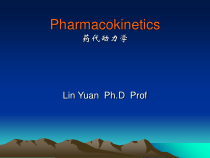 PPT
PPT
【文档说明】药代动力学C2PKEC课件.ppt,共(98)页,4.844 MB,由小橙橙上传
转载请保留链接:https://www.ichengzhen.cn/view-238955.html
以下为本文档部分文字说明:
Pharmacokinetics药代动力学LinYuanPh.DProf•学习要点:•基本要求:该部分的学习目的为掌握药理学的基本概念;熟悉与药理学基本概念相关的知识;了解药动学与药效学的相关公式与知识。•延伸要求:
将总论中的概念与相关生理生化知识﹑各论中药物的效应联系起来,该种联系贯穿药理学及其它基础与临床医学知识学习的始终。•学习方法:注意各种概念间的联系:如药物的跨膜转运与机体对药物的吸收﹑分布及排泄过程有关与药物的理化性质有关也与机体的状态有关。•Q-Descr
ibewhatispharmacokinetics?•Thestudyofthedynamicchangesofdrugsinthebody,thatis,theprocessofabsorption,distributio
n,biotransformation(metabolism)andexcretionofdrugsinthebody.•阐明药物在人体内的吸收、分布、代.谢和排泄的动态变化规律即药物在体内(1)所经历的过程(吸收、分布、代.谢和排泄—跨膜转
运);(2)变化的方式与结果;(3)影响因素(药物与机体两方面)。•药动学的特征:Likea“journey”ofdruginthebody---Howthe“journey”ofadrugisproceed:absorption,distrib
ution,biotransformationandexcretion.•Whathappenstodrug:looseactivity,increaseionicsolubility.•Whatfactors
influencethejourneyofadruginthebody?•药动学在科研方面的应用:Quantitativedescriptionofthetimecourseofdrugandmetaboliteconcentrationsinplasma,tissueandurin
e.•药动学的临床应用:GuidefordrugchoiceandadjustmentofdosageDistribution(tissue)DrugPlasmaBio-transformationliverExcretion,kidney药物在
体内的动态过程-1Absorption药物在体内的动态过程-2为什么A代表药动学,B代表药效学;C代表两者?Q-Whatisdrugtrans-membranetransport(跨膜转运)?•Toachievetherapeuticeffects,drugscrossvar
iousbiologicalmembranes,by被动转运passivetransportor/and主动转运(activetransport).•Drugtrans-membranetransportar
einvolvedinAbsorption,distribution,andExcretion.•CanyoudescribethatwhatdependsonforaAdrugtocrosscellmembrane
s?•Aretheresomethingsharedincommon?UnderstandFactorsinfluencestheprocess.1.molecularsize&shape2.solubilityatsightofabsorption3.ionisati
on4.lipidsolubilityFeatureandimportanceofPassivetransport(被动转运)(a)Themajorityofdrugsaretransportedbypassi
vetransport:Simplediffusion,Filtration,andsomebyFacilitateddiffusion(transport).Commonfeatures:(a)transportfromhightolowconcentration,anddependsoncon
centrationgradient;(b)needsnoenergy;(c)influencedbylipidsolubilityofdrugandbydifferencesinpHacrossthemembrane.Difference
:Facilitateddiffusion(a)needscarrier;(b)hasdrugtransportsaturation;(c)hasdrugcompetitionandselectivity.Simplediffusion,Fil
trationNocarrierneeded.2.Activetransport(主动转运)Activetransporthasfollowingfeatures:(a)needsspecialcarriers;(b)Requireme
ntofenergyconsumption.(c)Drugscantransportfromlowtohighconcentration.(d)presencetransportsaturationand(e)presenceofcompetitiveinhibiti
on.AlternativeclassificationCarriermediatedtransport(载体转运):ActivetransportandFacilitatedtransport(主动转运与易化转运)Non-carriermediatedtransport:Simple
diffusion,andFiltration(非载体转运)•carrier-mediatedtransport:Movementwhichoccursacrossmembranes,suchastheblood–brainbarrierandtheg
astrointestinalmucosa.Themechanismisalsocharacterizedby(1)beingsaturable;(2)competitiveinhibitionoccurs
.Therearetwoformsofcarrier-mediatedtransport,activetransportandfacilitateddiffusion.Therapidtransferofdrugmetabolitesintourineisbyactivetransport.
Entryofglucoseintomostcellsisbyfacilitateddiffusionbutitspassageacrossthegastrointestinalmucosaisbyactivetranspor
t.Passiveandactivetransport-2II.Theprocessofdrugtransport•Q-Whatisdrugabsorption(吸收)?Doallkindsofadministra
tionpossessabsorption?MovementofdrugmoleculesfromthesiteofadministrationtothesystemiccirculationbypassingthecellmembranebarrieriscalledAbsorpt
ion.•DrugadministrationOraladministration,(mostpopular,advantage:convenient,economical,andofefficiencyforabsorption).Di
sadvantage:irritationtogastrointestinalmucosa,irregularityinabsorption,andFirstpasseffect(metabolism,首关效应),whichmeans
thatorallyadministereddrugsaremetabolizedinintestinalflora,andliverwhenabsorbedfromhepaticportalsystembeforetheyfirstgai
naccesstothegeneralcirculation.首关效应:口服药物经肠道、肝脏门脉系统进入体循环前,被肠道菌群及肝药酶代谢,使进入体循环的药量减少,这样一种现象叫做首关效应。首关效应•(Hepatoenteralcircul
ation,肝肠循环):Drugisexcretedintothesmall,intestinebybilesecretion,andabsorbedthereagainiscalledhepatoenteralcirculation.PlotofCpversusTimeforAa
ndB;BhavingSlowerAbsorptionDoabsorptioninvolveinanytypeofadministration?TheimportanceofHepatic‘First-Pa
ss’effect(Metabolism)•Affectsorallyadministereddrugs•Metabolismofdruginliverbeforedrugreachessystemiccirculation•Drugabsorbe
dintoportalcirculation,mustpassthroughlivertoreachsystemiccirculation•Mayreducebioavailability(生物利用度)ofdrug。•Firstpasseffectisalso
atypeofbiotransformation,i.e.,theeliminationofasubstance,e.g.,adrugintheliverafterabsorptionfromtheintestineandbeforei
treachesthesystemiccirculation.•Sublingual(舌下)Drugsabsorbedsublinguallymeansdrugsareabsorbedthroughmouththinmucosaanddonothavefirstp
asseffectingastro-intestine.硝酸甘油(Nitroglycerin)•InjectionIntravenous(i.v.):directtogeneralcirculationandismostfastway.Theotherinjection
include:subcutaneous,intra-muscular.•Rectalmucosa(直肠粘膜)Advantage:Avoidvomiting,nofirstpasseffect,usedwhenpa
tientisun-coconscious.Disadvantage:rectalabsorptionisoftenirregularandincomplete.•IV(静脉注射injectionandinfusion)doesnotneedabsorption.•Local
anesthesia:drugabsorptionisthewayofelimination.•Drugsystemiceffectviadrugabsorbedintogeneralcirculation.Q
-WhatdoesbioavailabilitymeanBioavailabilityreferstotheextenttowhichadrugreachesitssiteofaction.(systemic,local)生物利用
度与药物能够达到作用的靶点有关。F=进入体循环的药量(A)用药剂量(D)×100%DosereachesthesystemiccirculationDose(administered)=ivadministrationF=×100%定义与公式见的关系,是否可用公式代替定义?•Bioava
ilabilityisusedtodescribethefractionofanadministereddoseofunchangeddrugthatreachesthesystemiccirculation,oneoftheprincipalpharmac
okineticpropertiesofdrugs.Bydefinition,whenamedicationisadministeredintravenously,itsbioavailabilityis100%.[
1]However,whenamedicationisadministeredviaotherroutes(suchasorally),itsbioavailabilitydecreases(duetoincompleteabsorptionandfirst-passmetabolism)o
rmayvaryfrompatienttopatient(duetointer-individualvariation).•Absolutebioavailability(绝对生物利用度)isthefractionofthedrugabsorbedthrough
non-intravenousadministrationcomparedwiththecorrespondingintravenousadministrationofthesamedrugAbsolutebioava
ilability(绝对F):F=AUCpoAUCIV×100%(相对生物利用度)(相对):F=AUCtestedAUCstandard×100%AUC(iv)AUC(po)PlotofCpversusTimeafterIVandIMAdministration.N
OTE:AUCsarealmostsame.•FoodEffectsonBioavailability•对于药物吸收,食物可以增加、降低或不影响药物的吸收Foodmayincrease,decrease,orhavenoeffectontherateand/ortheextentofab
sorption。•Mayaffectrateandextentindependently.•FoodEffectsGImotilityandalsocanincreasesolubilizationofdrugs•Changemaydependoncontentofmeal•Foodmay
mitigate(decrease)nausea•Vomitingtendstodecreasebioavailability•Timeofdosewithrespecttofood。(根据不同食物,选择不
同服药时间)。Bioequivalence(生物等效性)meansthatonebrandordosageformofadrugorsupplementisequivalenttoareferencebrandordosageformofthesamedrugintermsofbioa
vailabilityparametersmeasuredviainvivotestinginhumansubjects.Bio-equivalenceofhumandrugsmustbedeterminedinhumansviaestablishedmeasuresofbioava
ilability.两个药学等同的药品,若它们所含的有效成分的生物利用度无显著差别,则称为生物等效。•AUC–Areaundertheconcentration-timecurve•Cmax–Maximumconcentration–Ad
ifferenceofgreaterthan20%inCmaxortheAUCrepresentsasignificantdifferencebetweenthestudyandreferencecompounds•Tmax–Time
tomaximumconcentrationStudyCompoundReferenceCompoundTimeConcentrationCmaxTmaxAUC为了检验药物制剂与参比品在吸收利用的程度上是否一致,保证药物制剂的安全可靠性,特地规定药物制剂的AUC、Tmax及
Cmax应在参比品的80~120%范围内,称为“等效性检验”。其中AUC等效反映了吸收数量相近,Tmax等效说明吸收速率相近,Cmax则与用药安全性有关。Testofbioequivalence(生物等效性检验)•Q-Whatisdrugdistri
bution(分布)•Distributionistheprocessbywhichadrugdiffusesoristransferredfromintravascularspacetoextra-vasculars
pace(bodytissues).Inthesimplestofterms,adrug‘svolumeofdistributionisthatvolumeofbodilyfluidintowhichadrugdoseisdissolved.Therefore,ifweknowthed
osethatwasgiven,andwecanmeasuretheserumlevel(concentration),thenwecancalculateavolume:(药物自血液系统进入组织的过程)•Volumeofdistribution=Dose/drugc
oncentration;Vd=A/C•Vd(apparentvolumeofdistribution,表观分布常数)•A(totalamountdrugmg)•C(plasmaconcentrationofdrug)•Vd=A/C(C血浆药物浓度
)•(Vd)istheamountofdruginthebodydividedbytheconcentrationintheblood.Drugsthatarehighlylipidsoluble,suchasdigoxin,haveaveryhighvolumeof
distribution(500litres).Drugswhicharelipidinsoluble,suchasneuromuscularblockers,remainintheblood,andhavealowVd.•(表观分
布常数说明药物在体内分布范围,而不是实际分布体积).•Vd=A(dose)/C(concentration)•Systemicdistribution–Plasma3L(血浆)–Extra-cellular15L(细胞外液)–Intra-cellular40L(细胞内
液)•Bindingtobloodproteins•Unevendistributioninbodyorgans–Depositioninfattissue–Depositioninliver/kidneys–D
epositionintargetorgan•Internalbarriers-Bloodbrainbarrier/PlacentaQ-Describefactorsinfluencingdrugdistribution
1.bodyfactor(1)组织屏障Tissuebarrier(a)血脑屏障Bloodbrainbarrier,胎盘屏障placentabarrier,gastrointestinalmucosa,epithelialbarrierofskinor
bladder.(Thebarriersbetweenbraincellandblood,braincellandcerebrospinalfluid,aswellasbloodandcerebrospinalfluidarecalledbloodbrain
barrier.Nowhereinthebodyistheremoreneedforhomeostasisthaninthebrain.Bloodbrainbarrierprotectsbrainfrom
circulatingtoxin,highMWorhighlywatersolubledrugs,e.g.,quaternaryamines,andharmfulsolutes.Ifneeded,lipidsolubleagentisavailable.)Over100years
ago,theconceptofthebloodbrainbarrierwasfirstintroducedbyPaulEhrlich.Hefoundthatintravenousinjectionofdyesintothebloodstreamstainedallthetissue
sinmostorgansexceptbrainandspinalcord。Theresultssuggestthattheremustbeabarrierbetweenbrainandbody(b)Placentabarrier(胎盘屏障)Mostdrugsc
ancrosstheplacentaandenterthebreastmilk.Thedifferenceisthelimitedmaternalbloodflowingintoplacenta,thefastesttimefordrugequilibrati
onbetweenmotherandfetusisintheorderof10-15min.•Drugsharmfultofetusshouldnotbegiventopregnantwoman.孕妇应避免服用对胎儿有害的药
物(2)Absorbingsurface(3)Bloodflow(4)EnvironmentalpH(5)Diseasestates•Drugcanbedividedintoweakacidandweakbase(弱酸性药物
与弱碱性药物)•Q-Describetheformofweakacidinacidicandbasicsolution.•Q-Describetheformofweakbaseinacidicandbasicsolution.弱酸性药物在酸性条件下
呈分子状态弱碱性药物在碱性条件下呈分子状态推论:弱酸性药物在碱性条件下呈离子状态弱碱性药物在酸性条件下呈离子状态分子状态-脂溶性强-易被吸收离子状态-水溶性强-易被排泄弱酸(HA)弱碱(B)的分子与离子状态WeakAcidsRelease/DonateH+HAH++A-WeakBasesB
ind/AcceptH+H++BHB+HAH+↑+A-H+↑+BHB+Ionizedform(charged)A-Un-ionizedform(uncharged)HAHALipidBilayer弱酸与弱碱在细胞膜内外分布Ionizedform
A-Non-IonizedformHABHB+IntracellularpHi=7.0Plasma,ExtracellularpHe=7.4Non-IonizedformIonizedform•Describewhydruglipid/watersolubilityinfluencedrug
absorption/distribution/excretion?•(为什么药物的脂/水溶性影响药物的吸收/分布/排泄)•Drugdiffusionacrossmembraneisaffectedbythephysicochemicalproperti
esofdrugssuchasmolecularweight,polarity,lipid/watersolubility.•Mostdrugsareweakelectrolytes,andpresenceinbothunion
izedandionizedforms.Theunionizedformhasstrongerlipid-solubilityandiseasiertodiffuseacrossthemembraneduetothelipoidcharacteristicsof
thebiologicalmembrane.Theionizedformwhichhasstrongerpolarityisdifficulttodiffuseacrossthemembraneduetothewatersolubilitya
ndiseasiertobeexcretedfromkidney.LipidBilayerSmall,unchargedLarge,unchargedSmallchargedionsH2O,urea,CO2,O2,N2G
lucoseSucroseH+,Na+,K+,Ca2+,Cl-,HCO3-DENIED!DENIED!Swoosh!HydrophobicTailsHydrophilicHeads跨膜转运WeakacidpH–pKa=l
g(A-/HA)AcidicdrugsarebestabsorbedfromacidicenvironmentsWeakbasepKa-pH=lg(BH+/B)Basicdrugsarebestabsorbedfrombasicenvironmentsnu
meratorDenominator弱酸弱碱解离度与环境pH的关系MainlyHAandBH+MainlyA-andB•例如:某酸性药物pKa=7,计算其在pH=9,及pH=5时的吸收/排泄情况•pH=9的情况•pH–pKa=lg
(A-/HA)=9-7=2=lg(100/1)易排泄/难吸收。•pH=5的情况pH–pKa=lg(A-/HA)=5-7=-2=lg(1/100)•难排泄/易吸收。•小结:酸性药物在酸性环境下容易被吸收。•碱性药物在碱性环境下容易
被吸收。•AdrugpKa=7,calculatetheconditionofreabsorption/excretion•pH=9,及pH=5(1)pH=9的情况•pKa–pH=lg(BH+/B)=7-9=-2=l
g(1/100)难排泄/易吸收。(2)pH=5的情况pKa–pH=lg(BH+/B)=7-5=2=lg(100/1)易排泄/难吸收。•Q-HowtocalculatethepKaofadrug•pKaisthepHatwhichtheconcentratio
nofionizedandun-ionizeddrugissame(50%each)forbothweakacidicandbasicdrugs•Forbothweakacidicandbasicdrugs,e.g.,theirpKamaybe3.1,4.6,5.3
,7.4,8.6,9.2etc,atwhichthedrugconcentrationofionizedandun-ionizedformissame.PleasedescribetheimportanceofdrugP
lasmaProteinbinding(DPPB)(药物-血浆蛋白结合的重要性)1.Onlyfreedrughaspharmacologicaleffects,2.Reductionofdrugdistribution,biotrans-formationandexcretion3.Dru
g-plasmaproteinbindingisreversibleandisservedasadrugreservoir4.Acompetitionsiteformanydifferentdrugs5.DPPBactasatransport
mechanismforthedrugtothesiteofactionorelimination.(relatedtodrugdistribution)WhereisDrugstoredinthebody•(1)Plasm
areservoir•(2)Cellular(tissue)Reservoir•(3)FatReservoir•(4)BoneReservoirBIOTRANSFORMATION1•Definition•Biotransf
ormationisanenzyme-mediatedtransformationofonechemicalintoanotherwithinthelivingorganism,e.g.,chemicaltransfo
rmationsofforeigncompoundsincludingdrugs.(在生物体内,由酶介导的,将外源性物质进行的化学转化,从一种物质转化为另一种物质)•TheplaceofBiotransformation:liver(main);smallintestine,lung,andki
dney,etc.(主要转化部位:肝脏)•Significance•Evolutionhasprovideduswithmechanismstoeliminatetheseforeigncompoundsfromourinternalenvironment.•Manydrugsar
ehighlylipid-soluble,unionizedatnormalpH,areeithernotreadilyfilteredattheglomerulusorareeffectivelyre-absorpe
dinthekidney.theyarebio-transformedintoaninactive,morecharged,water-solublemetabolitetoexcrete.BIOTRANSFORMATION2•Consequenceofbiotransfor
mation(生物转化的结果)(1)Inactivationandmorewatersoluble(most),e.g.,acetylsalicylicacid(aspirin)→aceticacid+salicylate.(2)Activecom
pound→activecompound,e.g.,diazepam(地西泮)→oxazepam(奥沙西泮).(3)Activation,e.g.,L-dopa(左旋多巴)→dopamine.(多巴胺)•Thedifferencebetweenbio
transformationandmetabolism•metabolismmeans"breakdown"and"inactivation".However,biotransformationincludenotonly"breakdown"and"inactivatio
n”butalsosyntheticreactions.BiotransformationReactions(BR)•BRincludephaseIandphaseIIreactions.•FeaturesofphaseIreaction
s(I相反应的特征)A.Converttheparentcompoundtoamorepolarmetabolitebyintroducingorbyunmaskingafunctionalgroupsuchasan-OH,-SH,orN
H2group.PhaseIreactionsincludeoxidation,reductionandhydrolysis.B.ThemetabolitesresultingfromaphaseIreactioncanbeinactive,lessactive,or
occasionallymoreactivethantheparentcompound.C.PhaseIReactionsdonotrequireenergy.•PHASEIREACTIONSPHASEIREACTI
ONSReactionsClassStructuralChangeDrugSubstratesOxidationsP450-Aromatichydroxylations•Propranolol,phenoba
rbital,phenytoin,amphetamine,warfarin-Aliphatichydroxylations•Amobarbital,pentobarbital,chlorpropamide,ibuprofen,digitoxinRCH2CH3RCH
2CH2OHRCH2CH3RCHCH3OHPHASEIREACTIONSReactionsClassStructuralChangeDrugSubstrates-Oxidativedealkylation-O-dealkylation-S-dealkylation•Codeine,p-nitro
anisole•6-methylthiopurine•Aniline,chlorphentermine•2-acetylamino-fluorene,acetaminophenROCH3ROH+CH2ORSCH3RSH+CH2ON-oxidation1°amines2°aminesRN
H2RNHOHR1NHR2R1NOHR2CH3OCHOHNCH3OCHONSO3-C6H8O6-NOHCOCH3NOHCOCH3SGNOHCOCH3Acetaminophen(APAP)PAPSPAPPhenolsulfo-t
ransferaseAPAPSulfateUDP-glucuronosyl-transferaseUDPUDPGAAPAPGlucuronideGSHGlutathioneconjugateN-acetyl-p-benzoquinoneimine(toxic)P45
0,PHS◼PhaseII(SyntheticorConjugation结合)ReactionsA.usuallyrequireenergy,nearlyalwaysinactivatesparentcompound,withfewexception.B.PhaseIIr
eactionsare"conjugationreactions".Inhumans,glucuronidationisthemostimportantone.C.Theconjugationreactionsfrequentlyoccurafterani
nitialPhaseIreaction.Thereactionistomakethedrugmorepolar,andmorereadilyexcreted.PhaseIandIIreactionsCytochromeP450enzymes细胞色素P450酶
▪Theendoplasmicreticulum(内质网,ER)membranesoflivercellscontaincytochromeP450enzymes(mixedfunctionoxidases(混合功能氧
化酶),monooxygenases,hepaticdrugmetabolizingenzyme(HDME)(肝脏药物代谢酶).•Reaction:Theenzymesrequiresbothareducingagent(NADPH)andmolecularoxygen,and
thekeystepistoinsertanO2intothesubstrate.•CharacteristicsofHDME(肝药酶作用的特征)•Non-selective:(非选择性)Alldrug
s(foreignsubstance)canbebiotransformed(detoxification).•Inducible(可诱导)increaseactivitiesofHDME)•Subtype:18differentformsofcytochromeP450(CYP)iden
tifiedinhumans;eachtheproductofaseparategene.ImportantcytochromeP450sinhumansare:CYP3A,CYP1A2,CYP2C,CYP2D6,CYP2E1.•CYPfamilyofenzymesimportanttod
rugdegradationinliverandinsmallintestine.Whydrugmetabolizingenzymeisimportantfordrugtherapy?Sixtypercentoforaldrugsmetabolizedprimarilybyaspeci
ficformofHDME-CYP3AFortypercentofdrugcandidatesfailbecauseoforalbioavailabilityproblemsOvercomingthe
‘firstpasseffect’mayresultinhighoraldosesorresortingtoIVadministrationCYP3Ainhibitorsboostoralbioavailability•Geneticdifference
(mostimportant):geneticdifferencesinpeople’sabilitiestometabolizedrugsthroughcertainmetabolicpathways•Environmentalfac
tors:Exposuretoenvironmentalpollutants&industrialchemicals•Physiologicalfactors:Disease,gender,age(drugmetabolisminelderly)•
hepaticdrugmetabolizingenzyme:Induction/inhibition•Metabolicdruginteraction•QDothesefactorsaffectpharmacologicaleffectsofadrug?影响药物生物转化的因素一室模型与二室模
型OnecompartmentTwocompartmentevenly(harmoniously)distributed•Q-Describethecharacterizationoffirstorderkinetics(一级动力学)•Aconstantfractionofthedruginth
ebodyiseliminatedperunittime.Therateofeliminationisproportionaltotheamountofdruginthebody.Themajorityo
fdrugsareeliminatedinthisway.•dC/dt=-KeC(Ke:Eliminationrateconstant,消除速率常数)•C=C0e-kt(Ke=Km(代谢速率常数)+Kex(排泄速率常数)。••Concentrati
on(C)intheplasmadecreasesatarateproportionalatalltimes(t)tothedrugconcentrationitself.(代谢速率与血药浓度成正比)•Thehalflifeoffirstorderkine
ticsisconstant.(半衰期恒定)•Mostdrugsdisposedinthemanneroffirstorderkineticsinasemilogarithmicfashion(timevslnCislinear).(时间与血药浓度对数作图为一直线)。ZeroOr
derKinetics零级动力学•-dC/dt=K•Therateofdrugeliminationisconstant.(消除速率恒定,因为达到了肝药酶的最大代谢能力)。•Thepseudohalf-lifeispropor
tionaltothedose.(半衰期与剂量成正比)•Graphically,thedrugconcentrationvstimeyieldsastraightline.(浓度对时间作图为一直线)。•The
eliminationofmostdrugsundergoesFirstorderkinetics.However,ifinhighdoses,theeliminationofsomedrugschangedintoZeroorderkinetics,becauseofthes
aturationofhepaticdrug-metabolizingenzyme,e.g.,aspirin.(肝药酶的饱和)lgCCttFirstorderkineticsZeroorderkineticsHalf-life(t1/2)(first-o
rderkinetics)半衰期•dC/dt=-KeC,dC/C=-Kedt•Ct/C0=e-Ket•ln(Ct/C0)=-KetWhenCt=½C0•ln((1/2)Ct/C0)=ln(1/2)=-l
n2•-ln2=-Ket1/2•ln2/Ke=t1/2t1/2=0.693/Ke•Half-life(t1/2)Eliminationhalflife:thetimetakenfordrugplasmaconcentrationtoreduceby50
%.After4halflives,eliminationis94%complete.半衰期:药物在血浆中消除一半所需要的时间K=0.693/t1/2Onet1/2(8h)onedose,4-6t1/2reachtoCss(steadystateconcentrat
ion)(50%,75%,87.5%,93.8%,96.9%,98.5%)最小有效血药浓度•思维综合锻炼(摘自美国医师考试,略加修改)•Apatientof70kgwasgivenadrug(5mg/kg)intravenously.Thedrugplasmaconcentrationswer
emeasuredaftertheendoftheadministration.•Seegraphnextpage.201075321018mg/Lαphase—distributionphaseβphase—eliminationphaseTimeafterdosingstoppedDrugp
lasmaC(h)mg/L0.018.00.510.01.05.82.04.63.03.74.03.05.02.46.01.98.01.3Q.Theeliminationhalf-life(t1/2)ofthedruginthepatientisapproximately•A.0.5h
•B.1.0h•C.2.0h•D.3.0h*•E.4.0h•Theeliminationconstant(ke)ofthedruginthepatientwasapproximately•A.0.17h-1•B.0.23h-1*•C.
0.35h-1•D.0.69h-1•E.1.39h-1•t1/2(h)=0.693/ke;ke=0.693/t1/2(h)•QVd(Theapparentvolumeofdistribution)inthepatientwasapproximately•A.
10L•B.20L•C.30L•D.40L•E.50L•••Vd=A/C=totalamountofdruginthebodyDCinplasmaat0timeofelimination5mgx70kg=350mg7mg/L=7mg/L=50LDC=DrugConcentration•E
xcretionofDrugs药物排泄•Drugseliminatedasmetabolites(common),asunchangeddrug(rare)主要以代谢产物形式排泄•(Polarmetabol
itesmoreeasilyexcretedthanlipidsolublecompounds)水溶性代谢产物易排泄•Kidney:mostimportantorganofexcretion(urine)排泄器官肾脏••O
therexcretoryorgansincludeintestines•(bile&faeces),lungs(exhaledair),breastmilkandsweatRenalExcretion-2•Renalexcretioninv
olves:•Glomerularfiltration(肾小球滤过)dependingonGlomeruarfiltrationrate&plasmaproteinbinding•Activetubularsecret
ion(主动肾小管分泌):organicanions&cationsaddedtoglomerularfiltratebyactivecarrier-mediatedsecretioninproximaltubule(e.g.penicilli
n)•Tubularreabsorption:nonionisedformsofweakacids&basesundergoreabsorption,bypassivediffusion(pHdependent)•Renaldisease–Slowsexcretion–Prolongs
effects•Renalclearanceisdefinedasthevolumeofplasmathatistotallyclearedofadrugin1minduringpassagethroughthekidneys.•Hepaticclearanceisdefinedasthevol
umeofplasmathatistotallyclearedofdrugin1minduringpassagethroughtheliver.总清除率(totalbodyclearanceorplasmaclearance)指机体
内各消除器官在单位时间内清除药物的血浆容积,是肝肾等)CL=Vd·Ke(Vd=表观分布常数,Ke=消除常数=0.693/t1/2)Apatienthasoverdosedonphenobartital.Phenobarbitalisanacid.Ifwe‘alkalinalize’theur
inebygivingbicarbonatewhatwillhappentothephenobarbitalmoleculesastheyarefilteredthroughtherenaltubules?UrinepHandElimination:iv
NaHCO3+phenobarbitalpH≥8.0O:ivNa2SO4+phenobarbital;pH≤7.0RelationshipBetweenAbsorption,Distribution,andEliminationAbsorptionDistributionElimin
ationRelationshipBetweenAbsorption,Distribution,andElimination(2)Pharmacokinetics&pharmacodynamicsvstimePeakofPharmacologicaleffects,adverseeffec
ts(Peakconcentration)
 辽公网安备 21102102000191号
辽公网安备 21102102000191号
 营业执照
营业执照